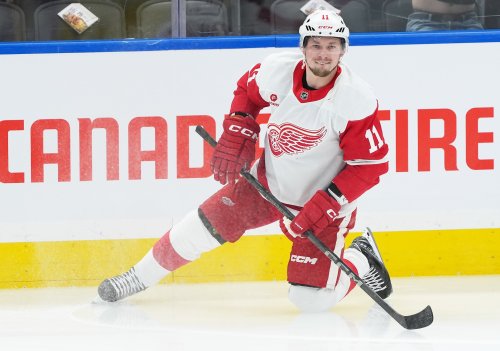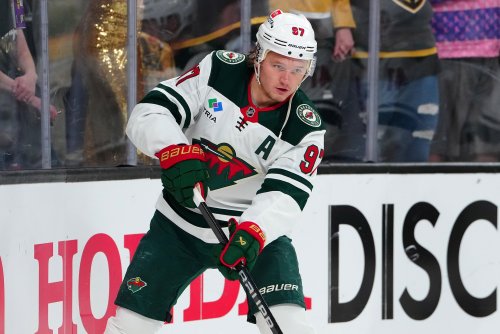.jpg.bdba5bec1750afdbee95d13e81a02c45.jpg)
“Flower” deserves all the flowers he’ll be showered with this weekend. Marc-Andre Fleury earned that with the few record-setting thresholds he has reached this season.
On December 31st, he became just the fourth goalie in NHL history to reach 1,000 games played. On Monday, January 15th, he moved into second place all-time in wins by a goalie in the NHL. He deserves to be recognized for both feats tonight when his former team, the Pittsburgh Penguins, visit the Minnesota Wild.
But where does Fleury rank all-time when discussing goalies to reach the pinnacle of their sport? Some could claim his standing as second all-time in wins as proof of his Hall of Fame status. But one could quickly point to that being a large by-product of the teams he has played on. And they would be somewhat right. Maybe it’s an accumulation of his nine All-Star Game appearances, three Stanley Cup wins, plus a Vezina Trophy that catapults him into the Mount Rushmore consideration.
The truth is that it’s really hard to compare NHL goalies historically. Even more than in the Connor McDavid vs. Wayne Gretzky debate, the multiple eras of the NHL make these sorts of declarations nearly impossible. Almost every goalie pre-1990 didn’t stand much of a chance due to the ridiculously laughable way goalies played at the time. You can’t compare Fleury to goalies in the 1990s and early 2000s during the pre-lockout dead puck era because, well, every goalie looks good when nobody can score!
With that, I wanted to look at Fleury through the lens of him and his peers in honor of what might be Fleury’s last memorable moment in a Wild uniform. First, because you can only compare goaltenders to that of their counterparts from the same era. It’s impossible to do so otherwise. Second, due to the new age of analytics, we are far more educated now to understand the true impact of a goaltender and his position.
Analytics in hockey can have their moment, good and bad, but there is no disputing it has given us a far clearer avenue to compare goalies and their impact on the ice. And when you dive into the numbers and dissect which are most important, it becomes pretty clear that the man they dub “Flower” is the second-best goaltender of his generation.
Why second best? Because No. 1 is not even a debate. Henrik Lundqvist is the greatest goaltender of this generation by a mile, and the data you are about to see proves it. But before we get into those muddy details and why Fleury barely inches out his counterparts for the honor of No. 2, we must establish what’s most important when valuing a goaltender and analytics's role in that.
For the longest time, counting stats like save percentage, goals against average per game, and wins were staples to understanding goalie impacts. But over time, those in the goaltending world started to poke holes into each category, even before analytics became mainstream. Goals against average (GAA) is fairly important. But how do you compare two goalies who each allow exactly two goals against per game, but one faces 15 more shots against on average? Save percentage is probably more accurate than GAA. But then again, not every shot is equal. Why should a save on an opposing team’s clearing attempt while killing a penalty equal the same value as stopping a breakaway?
With these questions came the introduction of analytics into hockey. Perhaps no analytic has been more impactful and accurate in improving our understanding of hockey than goals saved above expected (GSAx). If you don’t understand how GSAx works, here’s a quick refresher.
And it’s here that GSAx lands as the most accurate depiction of goaltender success. As analytics have become more and more relevant in hockey, they are becoming increasingly more relevant in roster construction. It has helped us understand that being a goalie in the NHL is really hard. It’s a volatile position to predict. The truth is that even the best goaltenders in the world have “down seasons” – unless your name is Henrik Lunqvuist.
Before GSAx, these down seasons by top goaltenders were often looked at as he simply didn’t have the same team in front of him. But GSAx removes much of that and places the onus squarely on the goaltender. And this understanding is the reason for most franchises moving away from the single goaltender anchoring their net to more of a platoon strategy. That sort of roster construction speaks to the value those in the industry place on GSAx.
With that, we are not getting into the weeds on this debate and will instead only use GSAx when comparing Fleury to other goaltenders of his generation. For this exercise, we only picked the goaltenders whose careers spanned the same timeline as Fleury. Players like Andrei Vasilevskiy and Ilya Sorokin will need to wait for the second half of their careers to take place for us to properly evaluate them.
We will judge Fleury and his peers on consistency and playoff success. Because if you ask any coach going to a season what they are asking of their goaltender, they want consistency in every game and each season, and a guy who can elevate his play in the biggest moments.
The numbers speak for themselves – Fleury stands behind only one since Evolving Hockey began tracking GSAx in the 2007-08 season. Only King Henry has been more consistent than Fleury in providing his team with a positive GSAx season throughout this era.

First of all, Lunqvuist is just ridiculous. He was the model of consistency in an era where we clearly established that goaltending can fluctuate from year to year. But enough of that, this is a Fleury article.
Longevity has long been a hallmark of Fleury’s game, but it’s much more than that. He’s just flat-out been far above average in most of the seasons he's played. Sure, some of those Carey Price and Sergei Bobrovsky peak seasons were pretty remarkable, but those were also sandwiched by a lot of below-average seasons. Outside of Lunqvuist, nobody has been more consistently counted on than Fleury.
But what about playoff success? Pittsburgh replaced Fleury twice in two separate Stanley Cup runs in his final seasons there. But those two seasons of struggles are on par with his peers, too.

Only King Henry and Jonathan Quick have proven more consistent in the playoffs throughout his career than Fleury.
And that brings us to this season. For obvious reasons, I didn't include the 2023-24 season in the above tables. But Quick is having a fantastic, bounce-back season in New York, and he’s taken the net from Igor Shesterkin for the time being. If he continues to be the man in net for them going into the playoffs and they make a run, you can make the case for Quick overtaking Fleury on this list. But he’s the only one on the list who can come close to making that claim.
But as we watch the NHL world celebrate Fleury and all his accomplishments, Flower stands alone as the second-best goaltender of his generation.
All statistics provided by Evolvinghockey.com.
Think you could write a story like this? Hockey Wilderness wants you to develop your voice, find an audience, and we'll pay you to do it. Just fill out this form.
-
 4
4








Recommended Comments
Join the conversation
You can post now and register later. If you have an account, sign in now to post with your account.
Note: Your post will require moderator approval before it will be visible.